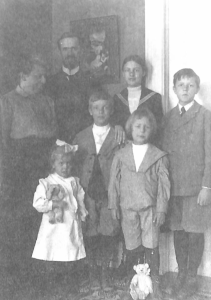 By Randy Tschetter
By Randy Tschetter
Director of the North American Baptist Heritage Commission
It may not qualify as a dynasty, but the name Rauschenbusch clearly holds a prominent place in the history of the North American Baptist Conference. One of the lesser-known but nonetheless impactful members of the family was Emma Rauschenbusch – the daughter and youngest child of missionary, seminary-founder, and professor August Rauschenbusch. Emma’s brother Walter served as the pastor of the Second German Baptist Church in New York City’s Hell’s Kitchen area from 1885 to 1896, where he became a strong advocate for social justice among the poor and disadvantaged before he followed in his father’s footsteps as a beloved professor at the Rochester Theological Seminary. Emma took a different route.
Martin L. Leuschner writes about the “missionary zeal” that motivated many of the German Baptists who had arrived in North America.[1] Although “the Cameroons of Africa have occupied the largest and most favored spot in the hearts of our people”[2] – as reflected in the number of documents and artifacts currently housed in the NAB Archives – some of the earliest attempts at overseas missions were focused on Asia, specifically China, Burma, India, and the Philippine Islands.[3]
Emma’s family heritage as the child of a missionary in which from early she had on been “introduced to the economic challenges of life in the poor neighborhoods in the United States,” prepared her to accept a call in 1882 from the American Baptist Foreign Mission Society to be a missionary to India.[4] Her work alongside other women missionaries involved “empowering the women of India for social change,” especially in the context of the Telugu Mission.[5] When evangelist Dr. John E. Clough returned to the United States in 1884, Emma provided leadership to the Telugu mission. She later returned home and earned her Ph.D. In 1894, she traveled to Vienna, Austria, where she reconnected with Dr. Clough, a former colleague and a widower who had spent many years as a missionary to the Telugu Mission in India. Following their marriage, they departed for missionary service in India, sent by the American Baptist Foreign Mission Society. While John and Emma were not officially sent as NAB missionaries, they did have the support of at least one denominational leader. As something of a side note, Frank Woyke points out that Emma’s father, August, himself a missionary, “had come to wish them well and to speed them on their way” to India.[6]
The Telugu Mission to which John and Emma were called was very much a ministry to a people group known as Dalits. The word Dalit – which means broken, torn asunder, downtrodden, scattered, crushed, or destroyed – refers to people in Indian society who were outcastes – people who did not fit into the traditional caste system of priest, warrior, merchant, or servant. Down through the centuries, the Dalits have been treated as “untouchable” due to their extreme poverty and pollution connected with their menial occupations, such as disposal of corpses.[7] In addition to her work of caring for outcaste women, Emma supported John, who was deaf, in his ministry of evangelism, a ministry characterized by his deep love for and respect for the culture of the Telugu people. As a woman, Emma had a unique understanding of the “aspirations of the Dalits,” which “provided a theological framework” for the social dimension of the Gospel.[8] Her academic skills enabled her to write several books, including While Sewing Sandals: Tales of a Telugu Pariah Tribe.[9]

The Walter Rauschenbusch family (l–r): Pauline, Walter, Winifred, Karl, Elizabeth, Paul, and Hilmar, ca. 1907.
The impact of Emma’s missionary work extends beyond the time she spent with the Telugu Mission. For sure, research and writings seem to have had a profound impact on her brother Walter’s spiritual formation, providing a theological framework for the Social Gospel movement in the West – a movement of which many North Americans are beneficiaries.[10] Moreover, the American Baptist Monthly (Spring-Summer – 2010) reports that some 640,000 Telugu Baptist Christians worship weekly in more than a thousand congregations.
I began my research for this piece wondering where or if I could find information concerning the life and ministry of Emma Rauschenbusch. I conclude with the realization that there is too much to tell in a short article and with gratefulness for the example of a faithful woman of God who has touched the lives of thousands by her example and ministry.
1. Martin L. Leuschner, “See His Banners Go,” in These Glorious Years: The Centenary History of German Baptists of North America 1843–1943 (Cleveland, OH: Roger Williams Press, 1943), p. 129. ↩
2. Leuschner, “Banners,” p. 141. ↩
3. Leuschner, “Banners,” p. 141. ↩
4. Chakravararthy R. Zadda, “The Story of the Social Gospel, The Story of the Telugu Church,” in In the Shadow of a Prophet: The Legacy of Walter Rauschenbusch (Macon, GA: Mercer University Press, 2020), p. 135. ↩
5. Zadda, “The Story,” p. 135. ↩
6. Frank H. Woyke, Heritage and Ministry of the North American Baptist Conference (Oakbrook Terrace, IL: North American Baptist Conference, 1979) p. 211. ↩
7. Zadda, “The Story,” p. 126. ↩
8. Zadda, “The Story,” p. 138. ↩
9. Zadda, “The Story,” p. 138. ↩
10. Zadda, “The Story,” p. 138. ↩